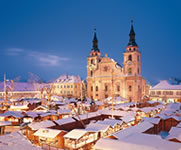
The fusion of Dutch and German architecture and craftsmanship is striking, particularly at Sanssouci Palace in Potsdam, for example, and in the Brandenburg capital's Dutch quarter. German towns such as Oranienburg and Oranienbaum reflect the close connections to the House of Orange in their name. In other towns, you'll find architectural or cultural monuments that reflect very important links with the House of Orange. The Dutch royal house actually originates from the Hessian town of Nassau-Dillenburg. It was here that William of Orange (or William the Silent), founder of the House of Orange, was born in 1533. The Oranje Route takes you on a fascinating journey to 25 German and Dutch towns, passing through holiday regions associated with the House of Orange-Nassau. The picturesque countryside through which the route passes also boasts an abundance of palaces, castles and magnificently landscaped gardens, as well as a whole host of cultural and historical treasures in museums and exhibitions, silent reminders of the wealth of times past that conjure up memories of the House of Orange.

This journey of discovery through the history of the House of Orange really has something to suit every taste with a tremendous wealth of art, culture and history. There are also walking and cycling trails for sporting enthusiasts, while watersports fans will be in their element in, on and around the water at around 3,000 lakes in Brandenburg, the German state with the greatest abundance of water. This tourist route is absolutely packed full of highlights and surprises. Whether you are travelling by car or by rail, you can set your own pace at all times. A warm welcome awaits you in the delightful towns and villages along the route with their lively centres and magnificent hospitality. A welcome that is fit for a king!




